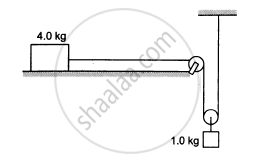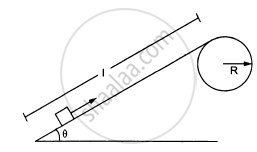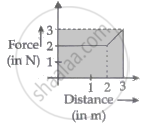Advertisements
Advertisements
प्रश्न
A heavy particle is suspended by a 1⋅5 m long string. It is given a horizontal velocity of \[\sqrt{57} \text{m/s}\] (a) Find the angle made by the string with the upward vertical when it becomes slack. (b) Find the speed of the particle at this instant. (c) Find the maximum height reached by the particle over the point of suspension. Take g = 10 m/s2.
उत्तर
\[\text{ Given }: \]
\[\text{ Length of the string, L = 1 . 5 m}\]
\[\text{ Initial speed of the particle, u } = \sqrt{57} \text{ m/s }\]
\[(\text{a}) \text{ mg } \cos \theta = \frac{\text{m}\nu^2}{\text{L}}\]
\[ \nu^2 = \text{Lg} \cos \theta . . . (\text{i})\]
Change in K.E. = Work done
\[\frac{1}{2}\text{m}\nu^2 - \frac{1}{2}\text{mu}^2 = - \text{mgh}\]
\[ \Rightarrow \nu^2 - 57 = - 2 \times 1 . 5 \text{g} \left( 1 + \cos \theta \right) \]
\[ \Rightarrow \nu^2 = 57 - 3\text{g }\left( 1 + \cos \theta \right) . . . (\text{ii})\]

Putting the value of \[\nu\] from equation (i),
\[15 \cos \theta = 57 - 3g \left( 1 + \cos \theta \right)\]
\[ \Rightarrow 15 \cos \theta = 57 - 30 - 30 \cos \theta\]
\[ \Rightarrow 45 \theta = 27\]
\[ \Rightarrow \cos \theta = \frac{3}{5}\]
\[ \Rightarrow \theta = \cos^{- 1} \frac{3}{5} = 53^\circ\]
(b) From equation (ii),
\[\nu = \sqrt{57 - 3g \left( 1 + \cos \theta \right)}\]
\[ = \sqrt{9} = 3 \text{ m/s}\]
\[ = 1 . 5 \cos \theta + \frac{\text{u}^2 \sin^2 \theta}{2 \text{g}}\]
\[ = \left( 1 . 5 \right) \times \frac{3}{5} + \frac{9 \times \left( 0 . 8 \right)^2}{2 \times 10}\]
\[ = 1 . 2 \text{m}\]
APPEARS IN
संबंधित प्रश्न
In a factory, 2000 kg of metal needs to be lifted by an engine through a distance of 12 m in 1 minute. Find the minimum horsepower of the engine to be used.
A block of mass 30 kg is being brought down by a chain. If the block acquires a speed of 40 cm/s in dropping down 2 m, find the work done by the chain during the process.
Consider the situation shown in the following figure. The system is released from rest and the block of mass 1 kg is found to have a speed 0⋅3 m/s after it has descended a distance of 1 m. Find the coefficient of kinetic friction between the block and the table.

A small block of mass 200 g is kept at the top of a frictionless incline which is 10 m long and 3⋅2 m high. How much work was required (a) to lift the block from the ground and put it an the top, (b) to slide the block up the incline? What will be the speed of the block when it reaches the ground if (c) it falls off the incline and drops vertically to the ground (d) it slides down the incline? Take g = 10 m/s2.
A block of mass 5 kg is suspended from the end of a vertical spring which is stretched by 10 cm under the load of the block. The block is given a sharp impulse from below, so that it acquires an upward speed of 2 m/s. How high will it rise? Take g = 10 m/s2.
The bob of a stationary pendulum is given a sharp hit to impart it a horizontal speed of \[\sqrt{3 gl}\] . Find the angle rotated by the string before it becomes slack.
Figure ( following ) shows a smooth track which consists of a straight inclined part of length l joining smoothly with the circular part. A particle of mass m is projected up the incline from its bottom. Find the minimum projection-speed \[\nu_0\] for which the particle reaches the top of the track.

A chain of length l and mass m lies on the surface of a smooth sphere of radius R > l with one end tied to the top of the sphere. Find the gravitational potential energy of the chain with reference level at the centre of the sphere.
A chain of length l and mass m lies on the surface of a smooth sphere of radius R > l with one end tied to the top of the sphere. Suppose the chain is released and slides down the sphere. Find the kinetic energy of the chain, when it has slid through an angle θ.
A chain of length l and mass m lies on the surface of a smooth sphere of radius R > l with one end tied to the top of the sphere. Find the tangential acceleration \[\frac{d\nu}{dt}\] of the chain when the chain starts sliding down.
A smooth sphere of radius R is made to translate in a straight line with a constant acceleration a. A particle kept on the top of the sphere is released at zero velocity with respect to the sphere. Find the speed of the particle with respect to the sphere as a function of the angle θ it slides.
A man, of mass m, standing at the bottom of the staircase, of height L climbs it and stands at its top.
- Work done by all forces on man is equal to the rise in potential energy mgL.
- Work done by all forces on man is zero.
- Work done by the gravitational force on man is mgL.
- The reaction force from a step does not do work because the point of application of the force does not move while the force exists.
Give example of a situation in which an applied force does not result in a change in kinetic energy.
Two bodies of unequal mass are moving in the same direction with equal kinetic energy. The two bodies are brought to rest by applying retarding force of same magnitude. How would the distance moved by them before coming to rest compare?
A raindrop of mass 1.00 g falling from a height of 1 km hits the ground with a speed of 50 ms–1. Calculate
- the loss of P.E. of the drop.
- the gain in K.E. of the drop.
- Is the gain in K.E. equal to a loss of P.E.? If not why.
Take g = 10 ms–2
Suppose the average mass of raindrops is 3.0 × 10–5 kg and their average terminal velocity 9 ms–1. Calculate the energy transferred by rain to each square metre of the surface at a place which receives 100 cm of rain in a year.
A rocket accelerates straight up by ejecting gas downwards. In a small time interval ∆t, it ejects a gas of mass ∆m at a relative speed u. Calculate KE of the entire system at t + ∆t and t and show that the device that ejects gas does work = `(1/2)∆m u^2` in this time interval (neglect gravity).
A particle moves in one dimension from rest under the influence of a force that varies with the distance travelled by the particle as shown in the figure. The kinetic energy of the particle after it has travelled 3 m is ______.

